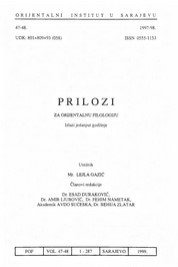GEMINIRANI KONSONANTI U LJETOPISU MULA MUSTAFE BAŠESKIJE
GEMINATED CONSONANTS IN THE CHRONICLE BY MULA MUSTAFA BAŠESKIJA
Author(s): Kerima FilanSubject(s): Cultural history, Theoretical Linguistics, Lexis, Comparative Linguistics, Bosnian Literature, 18th Century, Turkic languages
Published by: Orijentalni Institut u Sarajevu
Keywords: The Chronicle; Mula Mustafa Bašeskija; Bosnian literature; Turkish language; Gemination in the dialect;
Summary/Abstract: The subject of this work are the geminated consonants in The Chronicle (Ljetopis) by Mula Mustafa Bašeskija, that were written in Turkish, with certain elements of the Turkish used by the people of Bosnia and Herzegovina. This dialectic peculiarities are clearly shown by the way geminated consonants are written. It has been discovered that Bašeskija wrote some of the Turkish words with tasdîd (illerii, kıssa), while the others have tašdid only partially (billur, çölle, üççer). Considering the fact that the gemination of the consonants is an unknown category in Turkish language, this secondary gemination is considered to be the characteristic of Turkish spoken by the population of Bosnia. Further on, this work gives a review of words with etymological gemination written without tasdîd in The Chronicle. On the one hand, it has been pointed out to the examples widely used in Turkish with reduced gemination, and adopted as such in Bosnian dialect of Turkish. In the text of The Chronicle, this phonetic change is shown by the spelling of the lexeme without the tasdîd (kasab) or with modified spelling (saraç, tabak).
Journal: Prilozi za orijentalnu filologiju
- Issue Year: 1999
- Issue No: 47-48
- Page Range: 17-28
- Page Count: 12
- Language: Bosnian

